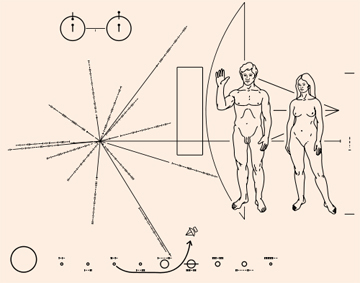How would a contemporary artist represent humanity to extraterrestrial life?
Recently I was visiting the American Museum of Natural History to take a friend to the planetarium. During the show “Journey to the Stars,” I was reminded of an odd moment in our space history: the inclusion of an engraved plaque on the Pioneer spaceship as an attempt to communicate peaceful human existence to any extraterrestrial life the spaceship might encounter on its trip outside our solar system. As someone interested in visual arts and culture, I was fascinated to learn more about how the story of human life was represented on the plaque. Looking at the image of the plaque above, what do you notice first? Is there anything that strikes you as odd or out of place? When I began to study the plaque, I noticed a few key assumptions the designers made about extraterrestrial life, and began to imagine how contemporary artists might have done it differently.
While examining the Pioneer Plaque, there are three things that jump out at me. One – the engraving depicts a space shuttle, the solar system, and a naked man and woman, leaving out any representation of culture, tradition, or identity. Two – this is a flat, 2-dimensional six inch by nine inch engraved surface that can be observed only through sight. There is no inclusion of sound, texture, taste, or movement. So the designers assumed extraterrestrial beings must have eyes or be able to observe engraved imagery. Not only that, but my third observation was that the engraving’s scale is based off the hydrogen atom being the common denominator of measurement; very few people on Earth would be able to even decipher the hydrogen symbol. The concept of a “universal” sign for anything begins to seem quite earthly. The designers not only assumed that encountered life would be able to read flat imagery, but would also be of like-minded intelligence of the scientist, and be able to recognize the symbol and measurement of a hydrogen atom. It’s not quite fair to say this is a narrow-minded attempt at representing human kind, but I would say it is not the most imaginative representation.
The plaque was designed around 1970 and offers a unique representation of humankind: if we put aside the questionable legibility of the materials and medium for now, you can see that NASA had intentions of demonstrating humility, scientific ambition, and discovery through the Pioneer Plaque. If you think of the artists working in the 1970s, they would have brought very different intentions to the challenge of communicating human existence. The works of the 1970s were experimental, bodily, and mysterious, like John Cage’s “silent” music compositions, or Andre Cadere‘s round wooden bars with their handcrafted, hand-painted quality but bizarre shape and size, which upset the traditional hanging or placement of objects in a gallery. Or how about Vito Acconci‘s Seedbed, as he silently masturbates under a ramp out of sight from his gallery visitors, performing human lust? This was also the time of the rise of the Feminist art movement, with Judy Chicago beginning to work on The Dinner Party in 1974, which sets elaborate placements at a triangle-shaped banquet table for heroic women of our past. How might these artists have represented the story of mankind differently? Themes of globalization, gender equality, and sexuality would take center stage in their work, but I could also imagine their contributions to be far more experiential. I’m thinking also of Tom Sachs’ Space Program: Mars at the NY Armory this summer, which took a satiric stance on the increased role of corporations in privatized space travel. The Tom Sachs Space Program, with the bricolage style re-creation of space shuttles, also proves that the story of humankind — ambitions, intention, size, scale, etc. — is told through our objects and process in space exploration, rather than pictorial representation.
So what have we learned through this process of comparing the representation of human existence on a plaque to similar themes addressed by artists at that time? It reveals that in the case of both the Pioneer Plaque and the works of contemporary artists, the process of creating an object itself tells more about the story of humankind than a representation ever could. Through this process of thinking about the Pioneer Plaque as a story of humankind, and imagining the different ways a contemporary artist might have taken on the challenge, I’m reminded of what contemporary artists do so well: they remind us to question the object. To think about the process of making it as the valuable plot, not the content of the object itself. The context and process of telling the story or creating the object tells us more about ourselves than anything else.
Colleen Brogan is an online learning specialist and museum educator. She has worked with The Museum of Modern Art, the Google Art Project, Smarthistory, and the Institute of Contemporary Art/Boston to create online content for art education initiatives. Colleen graduated with honors in Art History and French Semiotics from Brown University in June 2010 and currently lives in New York.





Pingback: The Things I Find for You | KELLY 2D